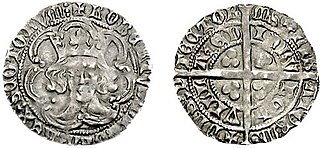
Robert III, born John Stewart, was King of Scots from 1390 to his death in 1406. He was also High Steward of Scotland from 1371 to 1390 and held the titles of Earl of Atholl (1367–1390) and Earl of Carrick (1368–1390) before ascending the throne at about the age of 53 years. He was the eldest son of King Robert II and Elizabeth Mure and was legitimized by the second marriage of his parents and by papal dispensation in 1349.

Francis Hay, 9th Earl of Erroll was a Scottish nobleman. A convert to Catholicism, he openly conspired with the king of Spain to try to unseat the Protestant Queen Elizabeth.
William Sinclair (1410–1480), 1st Earl of Caithness (1455–1476), last Earl (Jarl) of Orkney, 2nd Lord Sinclair and 11th Baron of Roslin was a Norwegian and Scottish nobleman and the builder of Rosslyn Chapel, in Midlothian.

Earl of Carrick is the title applied to the ruler of Carrick, subsequently part of the Peerage of Scotland. The position came to be strongly associated with the Scottish crown when Robert the Bruce, who had inherited it from his maternal kin, became King of the Scots in the early 14th century. Since the 15th century, the title of Earl of Carrick has automatically been held by the heir apparent to the throne, thus the current holder of the title is Prince William, Duke of Rothesay.
George Gordon, 4th Earl of Huntly was a Scottish nobleman.

John Erskine, 2nd Earl of Mar was a Scottish politician, the only son of another John Erskine and Annabella Murray. He is regarded as both the 19th earl and the 2nd earl.
Hugh [probably Gaelic: Aodh], was the third successor of Ferchar mac in tSagairt as Mormaer of Ross (1323–1333).

Clan Sinclair is a Highland Scottish clan which holds the lands of Caithness, the Orkney Islands, and the Lothians. The chiefs of the clan were the Barons of Roslin and later the Earls of Orkney and Earls of Caithness.

Patrick Stewart, 2nd Earl of Orkney, Lord of Zetland was a Scottish nobleman, the son of Robert, Earl of Orkney, a bastard son of King James V. Infamous for his godless nature and tyrannical rule over the Scottish archipelagos of Orkney and Shetland, he was executed for treason in 1615.
Robert Stewart, 1st Earl of Orkney and Lord of Zetland (Shetland) was a recognised illegitimate son of James V, King of Scotland, and his mistress Eupheme Elphinstone. Robert Stewart was half-brother to Mary, Queen of Scots and uncle to James VI and I of Scotland and England.
William Fowler was a Scottish poet or makar, writer, courtier and translator.
Alexander Leslie, Earl of Ross was a Scottish nobleman. Born between 1367 and 1382, he was the son of Walter Leslie, Lord of Ross and Euphemia I, Countess of Ross. In around 1394, or not later than 1398, he became Earl of Ross and sometime before 1398 he married Isabel Stewart, daughter of Robert Stewart, Earl of Fife who became Robert Stewart, Duke of Albany. They had one child, Euphemia. He died at Dingwall, Scotland on 8 May 1402.
Patrick Gray, 6th Lord Gray, known most of his life as Patrick, Master of Gray, was a Scottish nobleman and politician during the reigns of Mary, Queen of Scots and James VI of Scotland.
Patrick Leslie, 1st Lord Lindores was a member of the Scottish nobility.

Thomas Somerset, 1st Viscount Somerset (1579–1651) was an English politician who sat in the House of Commons between 1601 and 1611. He was raised to the Peerage of Ireland in 1626.
John Stewart, 5th Earl of Atholl, (1563–1595) was a Scottish landowner.

Elizabeth Howard (1564—1646) was an English aristocrat and courtier to Elizabeth I of England.

Robert Elphinstone, 3rd Lord Elphinstone (1530-1602) was a Scottish landowner and courtier.
Nicholas Stallinge or Stallenge was an English courtier.
Marie Ruthven, Countess of Atholl, was a Scottish aristocrat.










